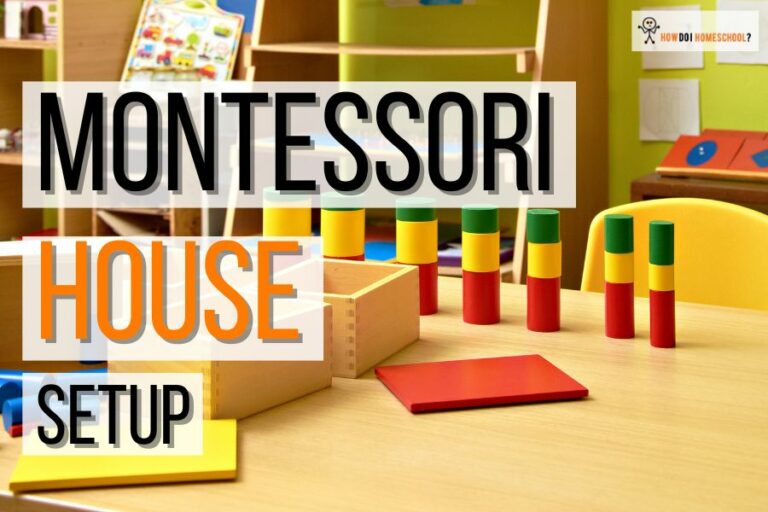
I hope you enjoy reading this blog post. If you want to do my course on how to homeschool, click here.
If you love the orderliness and independence the Montessori method promotes, you’ll love having a Montessori home, which will help your children develop these traits. You can make many areas of your house child-friendly by changing the children’s bedroom, schoolroom, and garden surroundings.
Contents of this article:
- Setting up a Montessori Home
- Toys and Games
- Mistakes you can Make When Looking at Materials and Setting up Your Home
- Cheaper Versions of Expensive Montessori Materials
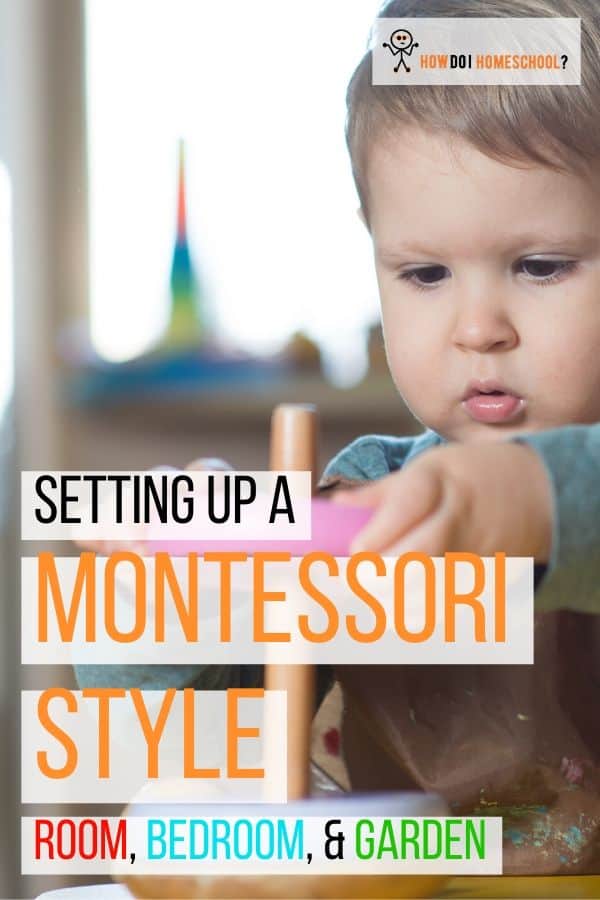
Affiliate links are used in this post.
Setting up a Montessori Home
When setting up your Montessori home, you want to keep in mind a couple of overarching themes, namely:
- Less is more – don’t give too many choices of activities or books, and don’t clutter the room. Store excess playthings in a cupboard.
- See the room as the child does – get down on their level and ensure students can see what you want them to see. This will also help you see the clutter.
At the end of this section, we’ll look at identifying when you have too many materials.
However, now it will be helpful to look at seeing a space or room as a child does.
Seeing Your Montessori Home Like Children Do
Get down on a child’s level and look at the room. Sitting down allows you to observe objects you need to move (like cords) or excess rubbish or clutter in the room.
In the video further down the page, the presenter asks us to consider if the artwork and indoor plants in the room are only for the adults (that is, at the adult’s height) or if there are artworks and/or plants on the children’s level.
Consider moving pictures closer to the ground if everything is at the adult’s height.
Montessori Homeschooling Room (Schoolroom)
In the homeschooling room where children do their schoolwork, you can have:
- a low-lying bookcase—any bookcase designed for a child to access at their own height will be fine. Make sure you place books facing outwards so the front covers are visible instead of just the spines. Also, toys should be placed on the shelves using a limited selection.
- other child-size furniture, such as a table and chairs for children to easily access.
- a mat where children can bring activities and play with them on the floor. This also helps them localize their mess to the mat.
- plenty of indoor plants to make a pleasant and lovely space for children. They’ll love watering them, too!
- some drying racks for paintings
These ideas will help children learn adult skills on a child’s level.
By the time they can reach adult equipment, they’ll know exactly what to do with it.
 The Montessori Bookshelf
The Montessori Bookshelf
When you set up your bookshelf, pay special attention to the way the book front covers face.
You want them to face outwards so children can admire the books and get excited about reading.
Remember that less is more, and you only want to display a limited number of books at once.
Too much choice is confusing for small children.
If you buy a modular bookshelf, you can put books in some sections and baskets or modular storage cubes in other sections.
The baskets can house smaller items, such as pencils or games children can play on their mats.
The cheaper version of a Montessori bookshelf is a few wooden boxes on the floor where you can stack books so children can flick through them easily and see the covers.
This means their books are still neat, and you’re still encouraging them to be orderly.
Child-Size Montessori Furniture
You can usually buy child-size furniture from a store like IKEA or Office Works.
In this video, the presenter shows us a child-size chair that is only 22cm high, a child-size table that is only 37cm high, and child-size shelves that are only 35cm high.
In the Montessori kitchen
Every Montessori home needs a great kitchen area. Items to make things easier for your children in their kitchen include:
- a water dispenser with a tray and cups,
- cleaning cloths for any spills that might result,
- chopping boards to deal with food items,
- utensils and napkins,
- aprons for preventing food spillage on clothing,
- a laundry basket for used aprons and spill cloths,
- child-sized dustpan, broom, mop, and any other relevant cleaning equipment,
- a compost bucket for any food scraps, and,
- snacks children can serve themselves.
You can put all these items on or under a child-size shelf in the kitchen, where children can get what they need.
A small stepping stool will assist children in reaching the sink area.
If you have the budget, you can buy a child-size Montessori kitchenette complete with a tap and removable plastic sink.
Near the kitchen area, you could also install hooks and handrails for drying aprons and washcloths.
The Montessori Bedroom
The most popular item to ‘Montissorify’ in the home is probably the toddler’s bed.
A low-lying toddler bed is among the most popular ways to incorporate the Montessori method at home.
Typically, a toddler’s bed is low to the ground, assisting children in safely entering and exiting it.
This increases their independence at bedtime and allows them to transition from the cot at an earlier age than is usually possible.
Of course, if you don’t want to buy an expensive bed, you can just put the cot mattress on the floor.
It’s not quite as cute but serves a similar purpose and is more affordable.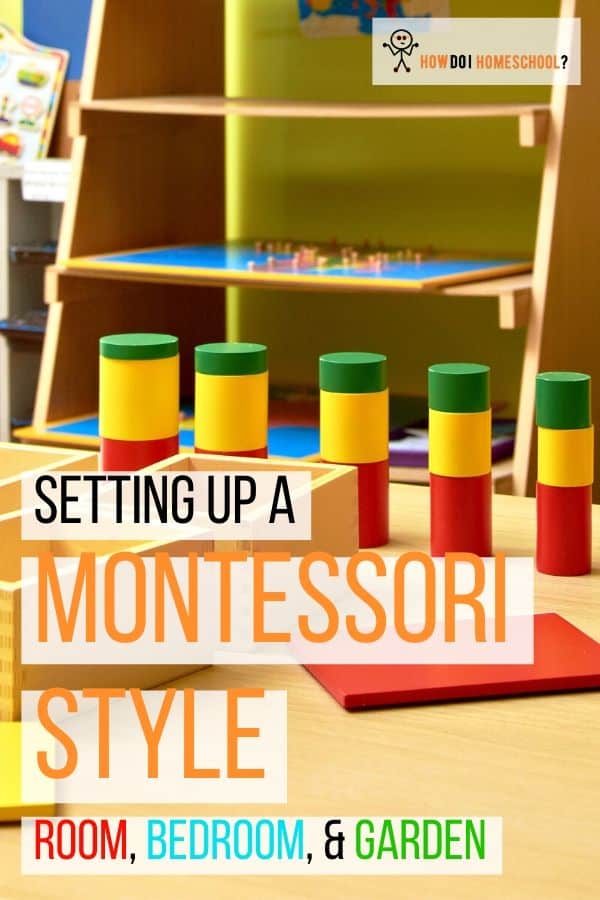
The Montessori bedroom should be inviting for children, with appealing wall art and a limited selection of toys.
Wall art can include pictures or hanging decorations like bunting or pom-poms.
To make the space even more attractive, include some live indoor plants. (Keep in mind that Montessori homes should be colorful places.)
Toys should be at eye level. Montessori toys are always made from natural wood, stone, or fabric.
A good option for boys might be a train set like this.
Consider including a bookshelf, small table, chairs, couch or armchair (and some rugs if you have floorboards).
For fun, you can include round log offcuts (only a few inches tall) for children to jump across the room.
Consider other fun objects like a climbing apparatus or some Montessori climbing stairs.
Every Montessori Home Should Have a Mat
Also, include a mat for children to bring their toys or activities to play on.
The mat can be any type – hessian, fur, or any different mat.
On the importance of the mat, I read this from a teacher:
During the first days of school, I teach my students how to roll and unroll a mat. I show them how to carefully take a mat from the basket, set it down on the carpet and unroll it. I also demonstrate how to walk around it without stepping on it. Afterwards, I teach them how to roll it up again by keeping the sides even. Finally, we talk about the importance of placing our work on the floor mat and walking around it, not on it.
What a great way to foster order and coordination in children – two key aims of this type of education!
The Garden
It’s easy to get caught up in designing indoor spaces.
However, the garden is an essential part of the Montessori environment.
It’s a calming space where children can learn independence and responsibility as they tend plants and grow vegetables.
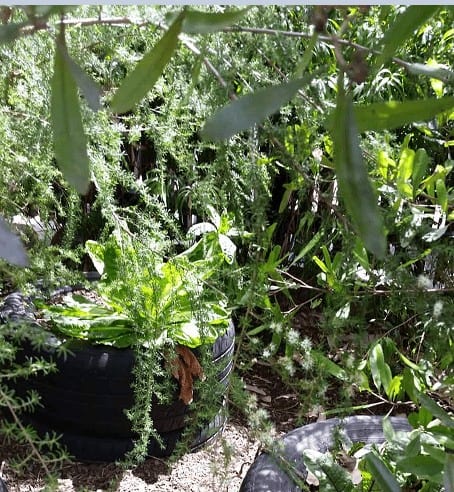
Your Montessori garden should include the following:
- slightly raised vegetable garden beds – places where children can garden easily.
- walking labyrinth– this is basically a bunch of stones that combine to form a maze for children to find their way through
- stepping stones or wooden log offcuts to step over
- signs to prettily show the way
- vegetable labels to indicate what’s growing in the garden and
- obstacle courses, climbing ladders, and stone walkways.
Of course, you don’t have to have everything in your Montessori garden, but these are some brief suggestions.
The Exciting Vegetable Garden
Children will love helping you water the garden, plant new flowers or vegetables, and pick fruits from trees.
Your students will constantly ask you about the garden’s produce, impatiently waiting for it to grow or ripen.
What fun, and what endless hours of fascination!
Mistakes You Can Make When Setting up a Montessori Home
Parents commonly make a couple of mistakes when they start setting up their Montessori homes.
These are being too hasty when purchasing materials and having too many of them.
Let’s discuss these mistakes below in more detail.
Being too hasty to purchase Montessori Materials
In Pitfalls of Montessori Homeschooling, the presenter examines one of the biggest pitfalls of setting up a Montessori home: buying materials too quickly.
The presenter says to be cautious about buying materials because some of these toys won’t be used by children, and they’ll sit on the shelf, becoming only expensive toys that carry dust.
Also, if you’re too hasty to make a purchase, you may become bitter towards this type of education, thinking it is only an expensive waste of money.
Why not avoid this mistake by using cheaper alternatives and constructing a few DIY activities?
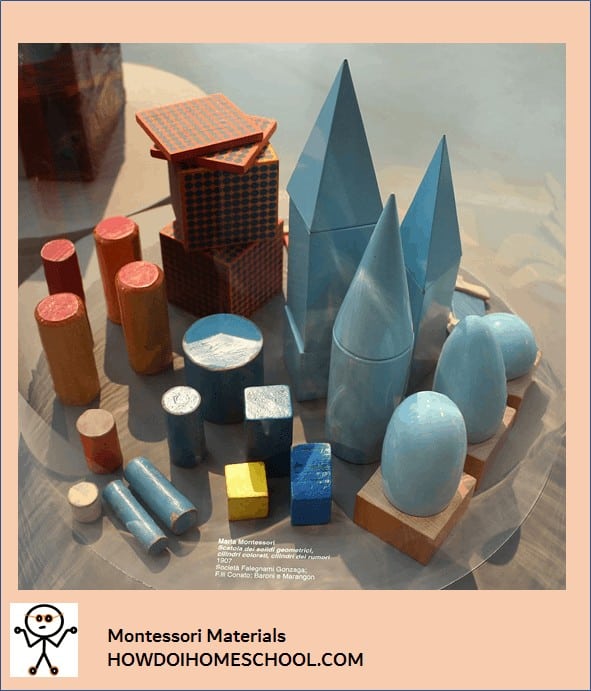
Having Too Many Montessori Materials
You can easily overwhelm children with too many materials, so start from scratch and put away all the existing toys.
Then add only about six Montessori activities back in—and make them good ones.
Then, you need to rotate these activities every week (and leave in the ones they are still using and interested in).
Cheap Montessori Materials for Your Montessori Home
You can avoid these mistakes by purchasing cheap materials from a $2 shop.
In the above video, the presenter suggests substituting expensive Montessori materials with the cheap options outlined below.
The cheap version of the:
- salt tray can be a low-profile plastic container with salt, sand, rice, or colored sprinkles
- spindle box can be magnetic number cutouts and some wooden popsicle sticks or dowels for the counters.
- counters can be magnetic numbers and flashcards with numerals on each card, plus marbles or glass pebbles for the counters.
- pouring pitcher is a plastic jug
- a transfer bowl (for transfer activities) can be a small plastic container with spouts. Then, buy beans or rice to be transferred to and fro.
You can also buy some tremendous cheap materials for your Montessori home, like:
- dustpan and broom for children to sweep their own messes
- washcloths for practice folding
- vases and fake flowers to practice flower arranging and
- socks to practice folding socks
These suggestions show that we can use many ordinary household items as substitutes for expensive toys.
Conclusion
A Montessori home is a great way to bring this fantastic educational method into your children’s everyday life. Some basic skills Maria Montessori valued – namely order, concentration, coordination, and cooperation – are incorporated into these ideas about the Montessori home, kitchen, bathroom, and bedroom. In addition, you can also have a tremendous amount of fun building your spaces – not to mention the amount of enjoyment you and your children will have living in and working in these spaces!
